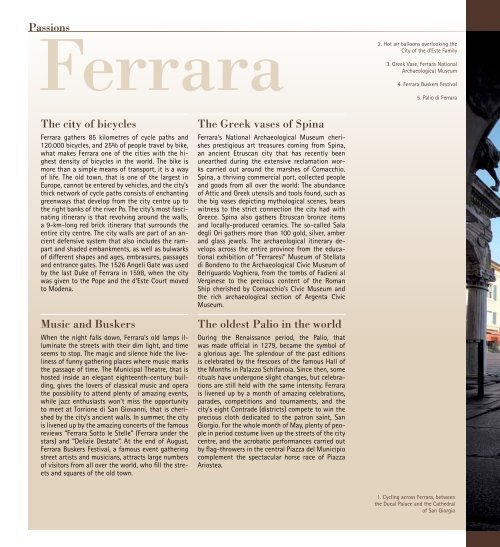of Emilia Romagna
of Emilia Romagna
of Emilia Romagna
Create successful ePaper yourself
Turn your PDF publications into a flip-book with our unique Google optimized e-Paper software.
Passions<br />
Ferrara<br />
2. Hot air balloons overlooking the<br />
City <strong>of</strong> the d’Este Family<br />
3. Greek Vase, Ferrara National<br />
Archaeological Museum<br />
4. Ferrara Buskers Festival<br />
5. Palio di Ferrara<br />
The city <strong>of</strong> bicycles<br />
Ferrara gathers 85 kilometres <strong>of</strong> cycle paths and<br />
120.000 bicycles, and 25% <strong>of</strong> people travel by bike,<br />
what makes Ferrara one <strong>of</strong> the cities with the highest<br />
density <strong>of</strong> bicycles in the world. The bike is<br />
more than a simple means <strong>of</strong> transport, it is a way<br />
<strong>of</strong> life. The old town, that is one <strong>of</strong> the largest in<br />
Europe, cannot be entered by vehicles, and the city’s<br />
thick network <strong>of</strong> cycle paths consists <strong>of</strong> enchanting<br />
greenways that develop from the city centre up to<br />
the right banks <strong>of</strong> the river Po. The city’s most fascinating<br />
itinerary is that revolving around the walls,<br />
a 9-km-long red brick itinerary that surrounds the<br />
entire city centre. The city walls are part <strong>of</strong> an ancient<br />
defensive system that also includes the rampart<br />
and shaded embankments, as well as bulwarks<br />
<strong>of</strong> different shapes and ages, embrasures, passages<br />
and entrance gates. The 1526 Angeli Gate was used<br />
by the last Duke <strong>of</strong> Ferrara in 1598, when the city<br />
was given to the Pope and the d’Este Court moved<br />
to Modena.<br />
Music and Buskers<br />
When the night falls down, Ferrara’s old lamps illuminate<br />
the streets with their dim light, and time<br />
seems to stop. The magic and silence hide the liveliness<br />
<strong>of</strong> funny gathering places where music marks<br />
the passage <strong>of</strong> time. The Municipal Theatre, that is<br />
hosted inside an elegant eighteenth-century building,<br />
gives the lovers <strong>of</strong> classical music and opera<br />
the possibility to attend plenty <strong>of</strong> amazing events,<br />
while jazz enthusiasts won’t miss the opportunity<br />
to meet at Torrione di San Giovanni, that is cherished<br />
by the city’s ancient walls. In summer, the city<br />
is livened up by the amazing concerts <strong>of</strong> the famous<br />
reviews “Ferrara Sotto le Stelle” (Ferrara under the<br />
stars) and “Delizie Destate”. At the end <strong>of</strong> August,<br />
Ferrara Buskers Festival, a famous event gathering<br />
street artists and musicians, attracts large numbers<br />
<strong>of</strong> visitors from all over the world, who fill the streets<br />
and squares <strong>of</strong> the old town.<br />
The Greek vases <strong>of</strong> Spina<br />
Ferrara’s National Archaeological Museum cherishes<br />
prestigious art treasures coming from Spina,<br />
an ancient Etruscan city that has recently been<br />
unearthed during the extensive reclamation works<br />
carried out around the marshes <strong>of</strong> Comacchio.<br />
Spina, a thriving commercial port, collected people<br />
and goods from all over the world: The abundance<br />
<strong>of</strong> Attic and Greek utensils and tools found, such as<br />
the big vases depicting mythological scenes, bears<br />
witness to the strict connection the city had with<br />
Greece. Spina also gathers Etruscan bronze items<br />
and locally-produced ceramics. The so-called Sala<br />
degli Ori gathers more than 100 gold, silver, amber<br />
and glass jewels. The archaeological itinerary develops<br />
across the entire province from the educational<br />
exhibition <strong>of</strong> “Ferraresi” Museum <strong>of</strong> Stellata<br />
di Bondeno to the Archaeological Civic Museum <strong>of</strong><br />
Belriguardo Voghiera, from the tombs <strong>of</strong> Fadieni al<br />
Verginese to the precious content <strong>of</strong> the Roman<br />
Ship cherished by Comacchio’s Civic Museum and<br />
the rich archaeological section <strong>of</strong> Argenta Civic<br />
Museum.<br />
The oldest Palio in the world<br />
During the Renaissance period, the Palio, that<br />
was made <strong>of</strong>ficial in 1279, became the symbol <strong>of</strong><br />
a glorious age. The splendour <strong>of</strong> the past editions<br />
is celebrated by the frescoes <strong>of</strong> the famous Hall <strong>of</strong><br />
the Months in Palazzo Schifanoia. Since then, some<br />
rituals have undergone slight changes, but celebrations<br />
are still held with the same intensity. Ferrara<br />
is livened up by a month <strong>of</strong> amazing celebrations,<br />
parades, competitions and tournaments, and the<br />
city’s eight Contrade (districts) compete to win the<br />
precious cloth dedicated to the patron saint, San<br />
Giorgio. For the whole month <strong>of</strong> May, plenty <strong>of</strong> people<br />
in period costume liven up the streets <strong>of</strong> the city<br />
centre, and the acrobatic performances carried out<br />
by flag-throwers in the central Piazza del Municipio<br />
complement the spectacular horse race <strong>of</strong> Piazza<br />
Ariostea.<br />
1. Cycling across Ferrara, between<br />
the Ducal Palace and the Cathedral<br />
<strong>of</strong> San Giorgio
















